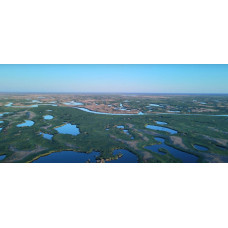The name comes from the capital letter of the Greek alphabet, by the resemblance to which it was given in ancient times to the triangular delta of the Nile River.
A delta is a shallow, gradually widening estuarine zone of a river, with an abundant network of numerous branches and channels, often arranged in a fan-shaped pattern. A delta is usually characterized by lush vegetation and an abundance of living organisms.
A delta is a lowland in the lower reaches of a river formed by river sediments and cut through by an extensive network of branches and channels. They represent a special mini-ecosystem both on the planet as a whole and in the basin of a particular river in particular.
The delta is formed as a result of the interaction of river flow, sediment runoff, sea surge, tides, and surge currents.
A delta that is not at the mouth of a river but, for example, in its middle or upper reaches is called an inland delta.
The opposite of a delta is an estuary - a single-sleeve, funnel-shaped river mouth that expands toward the sea.
The Amazon Delta, for example, begins about 350 km from the Atlantic Ocean. Despite its ancient age, it has not advanced into the ocean beyond its native shores. The reason for this is obviously the activity of the tides, the influence of currents, as well as the sinking of the shoreline. Though the river carries huge masses of detrital material into the ocean, all the listed above phenomena impede the process of the delta's accretion. The situation is similar in some of Russia's northern rivers such as the Amur, Ob, Taz, Pur, and others. For the same reason the presence and size of a delta almost irrespective of the river length. The Salween, which is 300 kilometers longer than the Irrawaddy, in contrast to the Irrawaddy, has almost no delta. Even the Neva, which is 71 km long, forms a delta.
Delta
Tags: delta

